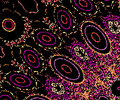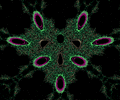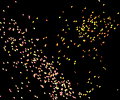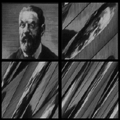After Dark Modules
The inspiration
These modules share somewhat of a common theme, and are intended to be more than just ways of making pretty pictures. They draw inspiration from the fields of dynamical systems, artificial life and chaos, and are all simulations in which simple rules give rise to complex behaviour or pattern formation. Where applicable, these rules act locally — for example in Buzzz!, each boid only consults a few nearest neighbours when setting its heading. In Autumn Leaves, there is no interaction between the leaves, but they are acted on by a force local to their current position.
A second inspiration here is to reproduce those patterns seen in nature, with such simple rules. Bird flocking (as in the bird option in Buzzz!) and leaves blowing in the wind are obvious examples. There is also a large class of cellular automata models which are designed reproduce natural phenomena, though these are less amenable to implementation as screensavers because of speed constraints.
If you are interested in programming your own After Dark modules for the Macintosh, I have some AD programming information online.
I am always on the lookout for candidate systems to add to this collection of ‘simple rules give complex behaviour’-type modules. If you have an idea of a possible system, I would be happy to hear about it.
I also have a page showing some of the modules that I have written, but never released for various reasons. [Warning — it’s graphics-intense.]
 Buzzz! 1.4
Buzzz! 1.4
An After Dark module for the Macintosh, simulating swarming insects with rendered graphics and something similar to Craig Reynolds’ flocking algorithm in Boids.
Here’s what they’ve said about it:

- “Man! it’s SU-GOI! (A Japanese word for Far-Out!). Best AD module I’ve ever seen!”
- “I don’t know if I can convey to you the wonder I felt, watching your perch swimming around on my screen. I honestly have tears in my eyes. They are magnificent. I do not own, nor have I ever seen any other program that captures such startling beauty.”
- “…the best no-nonsense, simulation type AD module ever written.”
- “Buzz is cool, good graphics although no one gives a flying shit on whether the patterns of the bugs flight paths are correct!”
Available from:
 Mazin’ Shapes
Mazin’ Shapes
An After Dark module for the Macintosh, drawing colourful graphics by iterating a simple transformation.
Here’s what they’ve said about it:

- “Wow! What a great screen saver module! I just wanted to drop you a line and say how much I enjoy having Mazin’ Shapes on my monitor.”
- “Nice job! Very entertaining.”
Available from:
 Morphin’ Shapes
Morphin’ Shapes
This module is based on the same algorithm as Mazin’ Shapes, but changes one of parameters in the equations on the fly, causing the amazing and colourful patterns to merge, one into the next.
Because this requires some serious floating-point performance, this module only runs on Power Macintosh computers.
Here’s what they’ve said about it:

- “Morphin Shapes is really cool!!”
- I really enjoy your After Dark screen saver, Morphin’ Shapes”
Available from:
 Autumn Leaves
Autumn Leaves
Autumn Leaves generates beautiful swirling patterns, like leaves in a breeze. It actually simulates the motion of particles in a discontinuous vector field, and gives remarkably interesting behaviour despite the simple underlying mechanism.
This module runs on all Macintosh computers with Color QuickDraw. A fat module, and one compiled to make use of the FPU on some 68k Macs, are included in the package. It uses direct-to-screen drawing for speed, though this can be optionally disabled.
Here’s what they’ve said about it:

- “Wow. Autumn leaves is the most awesome third-party AD module I’ve seen.”
- “…it’s the coolest module I’ve seen. I can see right now that I’m never going to get any work done and will probably soak my wristpad with drool. It’s amazing!”
Available from:
 Poincaré
Poincaré
Poincaré is an After Dark module for the Macintosh, that demonstrates Poincaré’s recurrence theorem. Essentially, that means that if you apply a transformation (to an image, in this case) enough times, you get back to what you started with.
This module runs on all Macintosh computers with Color QuickDraw, and is distributed as a fat binary.
Here’s what they’ve said about it:

- “Nice one.”
Available from:
permalink | computing/archaic/afterdark | 2007.11.19-22:33.00
